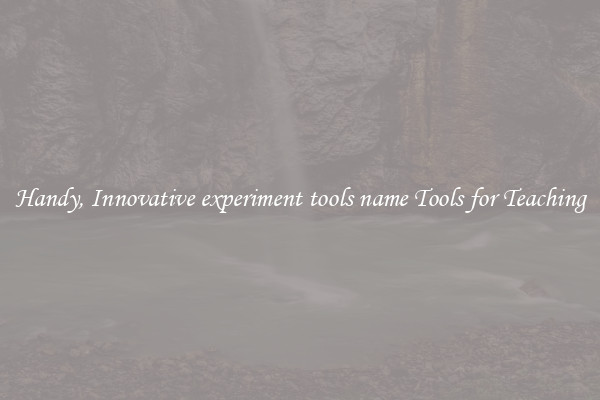Handy, Innovative experiment tools name Tools for Teaching
Tools for Teaching: Innovations in Experimentation

In the field of education, teachers are constantly seeking new and innovative ways to engage their students. One area where this is particularly important is in the realm of science experiments. Traditional experiment tools have often been cumbersome and time-consuming, making it difficult for teachers to effectively demonstrate scientific concepts. However, the emergence of handy and innovative experiment tools has changed the game, making the learning process much more efficient and enjoyable.
One such tool that has gained popularity is the digital microscope. This compact device allows students to examine objects in great detail by magnifying them digitally. With the ability to capture images and videos, it opens up a world of possibilities for interactive learning. Students can observe living organisms, study cellular structures, and even analyze different materials at the microscopic level. The versatility and convenience of the digital microscope have made it an indispensable tool for teaching.
Another handy experiment tool is the color-changing pH paper. Traditionally, measuring the pH of a substance required the use of a pH meter, which can be expensive and delicate. pH paper, on the other hand, is affordable and easy to use. By simply dipping it into the substance being tested, students can determine its acidity or alkalinity based on the color change of the paper. This tool allows for quick and accurate pH measurements, making it ideal for classroom experiments.
In addition to portable devices, the development of online platforms has revolutionized experiment teaching. Virtual laboratories provide students with the opportunity to conduct experiments in a simulated environment, eliminating the need for physical equipment. These platforms often include interactive simulations, data analysis tools, and detailed experiment procedures. Not only do they offer a safe and cost-effective alternative to traditional experiments, but they also allow for repetition and modification of experiments to enhance understanding.
Another innovation in experiment tools is the use of augmented reality (AR) in the classroom. AR technology enhances the learning experience by overlaying virtual objects onto the real world. Imagine students being able to explore the solar system in 3D, dissect animals without the need for physical specimens, or witness chemical reactions that are otherwise invisible to the naked eye. AR not only brings abstract concepts to life, but it also fosters curiosity and engagement among students.
In conclusion, the introduction of handy and innovative experiment tools has transformed the way teachers teach and students learn. From digital microscopes and color-changing pH paper to virtual laboratories and augmented reality, these tools make the learning process more accessible, interactive, and enjoyable. By harnessing the power of technology, educators can create memorable and meaningful experiences that inspire a lifelong passion for science.

View details

View details

View details

View details








